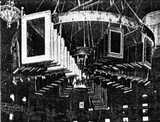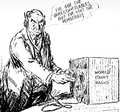Armistice Day, Nov. 11, 1921
The first major demonstration of the AT&T electric public address system was a great success. Celebrations were held simultaneously in New York City and Washington D. C. and San Francisco, linked by telephone wires and the new amplifiers, microphones, and loudspeakers developed by Bell Labs. The equipment had been first tested in public auditoriums during 1916 at Madison Square Garden in New York and at the Velodrome in Newark. It proved to be superior to the Magnavox system developed by Peter Jensen that was used for Woodrow Wilson's speech in San Diego. The AT&T system was used at the 1920 Democratic National Convention in San Francisco's Civic Auditorium. On March 4, 1921, a crowd of 125,000 heard the inauguration address of President Harding spoken into one of the new condenser microphones and amplified over loudspeakers at the Capitol in Washington D. C.  Harding honors unknown soldier grave in Arlington, from Literary Digest, 1921/11/26 Harding honors unknown soldier grave in Arlington, from Literary Digest, 1921/11/26 |
In Washington, 100,000 gathered at Arlington National Cemetery for the burial of the the Unknown Soldier. "Never before, perhaps, has there been such a gathering as assembled on the hills of the national cemetery overlooking Washington. While only a small portion who came to do honour to the Unknown could be accomodated within the enclosure where the leaders of this and other nations bowed before the bier of the unnamed hero, the vast multitude without, including ex-service men and many war mothers, followed the memorial ceremonies by means of the telephone amplifier, which impressively and with woderful distinctness reproduced the addresses. Not only the many thousands within the cemetery heard every detail of the exercises, but the nation's message of mourning was carried to distant cities."Upon every side of the immense amphitheatre the people massed. There they stood for many hours and followed the proceedings through the telephone amplifier which recorded the speeches and songs and prayers. While the scene within was impressive to the last detail because of its simplicity and the character of its actors, that without was equally so. When the President concluded his speech with the Lord's Prayer the crowds, head bared, repeated it. They sang 'Nearer My God to Thee' and the mighty voice was lifted to the far distant hills.
"The thousands at the tomb of the Unknown dead stood silent for two minutes at noon. This was the most impressive moment of the day. The crowds encircling the amphitheatre and overflowing the hills stood at attention. They bowed their heads in prayer. Not a single noise broke this silence, whil one looked about and saw many a woman in black weeping. Then a minute later 'America' was sung and the hills echoed with the words." (New York Times, 12 Nov. 1921, p. 4)
 Ten loudspeakers called "projectors" hang from center of ceiling in Madison Square Garden, eight were 7 ft. long , the two white speakers were 10 ft. long, with 5 music-master horns suspended vertically below, photo from AT&T Archives Ten loudspeakers called "projectors" hang from center of ceiling in Madison Square Garden, eight were 7 ft. long , the two white speakers were 10 ft. long, with 5 music-master horns suspended vertically below, photo from AT&T Archives |
"Work of installing the amplifying apparatus at Arlington Cemetery was begun on October 3. The control room was located in an underground corridor of the Amphitheatre and from this point the telephone engineers, like military officers in a dugout, directed operations during the preliminary tests and the actual ceremony, switched currents from one circuit to another and varied the volume of the sound produced by the various projectors which were erected in and about the Amphitheatre. Three separate transmitter locations were required because of the nature of the program. One of these was in the apse of the Amphitheatre, where President Harding's eulogy was delivered and the other earlier portions of the program were held. The second was at the grave, where the commitment services were read. A third was placed at the box where the quartet sang. A fourth transmitter, located in a padded telephone booth, was used in announcing the program over the long distance lines. Extensive tests were required before the location of the sound projectors at Arlington was finally determined. The peculiar construction of the Amphitheatre, which is circular in shape, with a colonnade surrounding it, presented problems in acoustics that were baffling in the extreme. The structure is of polished, white marble the properties of which are such that it lends itself peculiarly to the reflection of sound waves. The most careful location of projectors and the most delicate adjustments of currents were required to prevent echoes and reverberations from producing a veritable babel of sounds, particularly within the Amphitheatre. Thirteen ten-foot, two seven-foot, and five four-foot projectors, together with a music-master horn, were used." (An Epoch in Communications, pamphlet in AT&T Archives, Warren NJ) In New York, 50,000 veterans from every division that fought in World War I marched in a great parade down Fifth Avenue. All traffic and business stopped at
 Control room at San Francisco, with speaker hanging from ceiling on right, photo from AT&T Archives Control room at San Francisco, with speaker hanging from ceiling on right, photo from AT&T Archives |
noon for two minutes of silent prayer. "Nearly 1,000 veterans, gold star mothers, a large delegation of wounded and crippled soldiers, representative of 300 American Legion posts, veterans of the Grand Army of the Republic and other organizations and the general public took the 15,000 seats in Madison Square Garden long before the opening of the services, and a great crowd gathered in front of the Garden and in Madison Square, where powerful electric megaphones also trumpeted the vibrant tones of President Harding's address. The voices and the music, arriving over the telephone, were flung out from an amplifier about the size of an ordinary desk concealed behind flags on the speaker's platform. It penetrated with uniform distinctness to the parts of the auditorium remote from the speaker's platform."In the open air the President's voice swept over the crowd in Madison Square. The Voice seemed to come from the chest of a giant. Words which were strongly accented crossed the square to Broadway in one direction and to Twenty-third Street on the other. George Whitefield, the eighteenth century evangelist, who is said to have been the possessor of the most powerful voice in history, was considered a marvel to have made himself heard at half the distance. The music yesterday carried to the Flatiron Building." (New York Times, 12 Nov. 1921, p. 1)
"The President's voice carried by wire from Washington was heard more clearly that that of Colonel Theodore Roosevelt and Martin Littleton, whose voices were amplified as they spoke from the platform in the Garden.
 taps played at unknown soldier grave in Arlington, from Literary Digest, 1921/11/26 taps played at unknown soldier grave in Arlington, from Literary Digest, 1921/11/26 |
There seemed occasionally to be slight interference between the two kinds of sound - that which passed directly from their mouths to the ears of the audience and the very much louder tones which passed indirectly from their mouths to the audience by way of the amplifier on the platform in front of them. This occasional interference of sound waves made some of their words indistinct, but did not render them unintelligible. The sounds from Arlington, however, all came through the amplifier without disturbance from any second set of air waves.""The first words from Arlington Cemetery were those of a representative of the telephone who described the setting in Arlington Cemetery overlooking the Potomac with Washington in the distance and gave some of the details of the scene. The Audience broke into applause for the instrument after the first sentence had proved its astonishing reproducing qualities. Because of the solemnity of the subject, there was no further applause during the services until the close of the speech of the President, which was applauded nearly as heartily as if the Chief Magistrate had been there in person to hear it." (New York Times, 12 Nov. 1921, p. 7)
 Harding's World Court speech, from Literary Digest, 1923/07/14 Harding's World Court speech, from Literary Digest, 1923/07/14 |
In San Francisco, 20,000 in the Civic Auditorium heard the ceremonies transmitted from Arlington; they "listened in awed silence and marveled at this new miracle" as Harding's words were amplified "clear and distinct" over 3,800 miles of wire through 14 repeater stations. (San Francisco Chronicle, Nov. 12, 1921) Harding would continue to promote the use of public address systems, allowing amplifiers to be used at the dedication of the Lincoln Memorial May 30, 1922. He was the first president to have a radio installed in the White House Oval Office on Feb. 8, 1922. On his train trip to the West Coast in 1923, he had amplifiers and speakers installed on the back of the train for his speeches. His address in St. Louis June 22, 1923, was linked by telephone lines to radio stations in distant cities and an estimated record audience of one million people heard Harding argue for American membership in the World Court. His speech planned in San Francisco July 31, 1923, was to be connected coast-to-coast by telephone wire and radio, with hotels and public halls all over the country installing speakers so people outside in the streets could hear the broadcast. But Harding fell ill in the Northwest and died August 2 without making the speech.
© 1999-2001 by Steven E. Schoenherr. All rights reserved.
|
Return to Recording Technology History Notes | this page revised Jan. 3, 2001